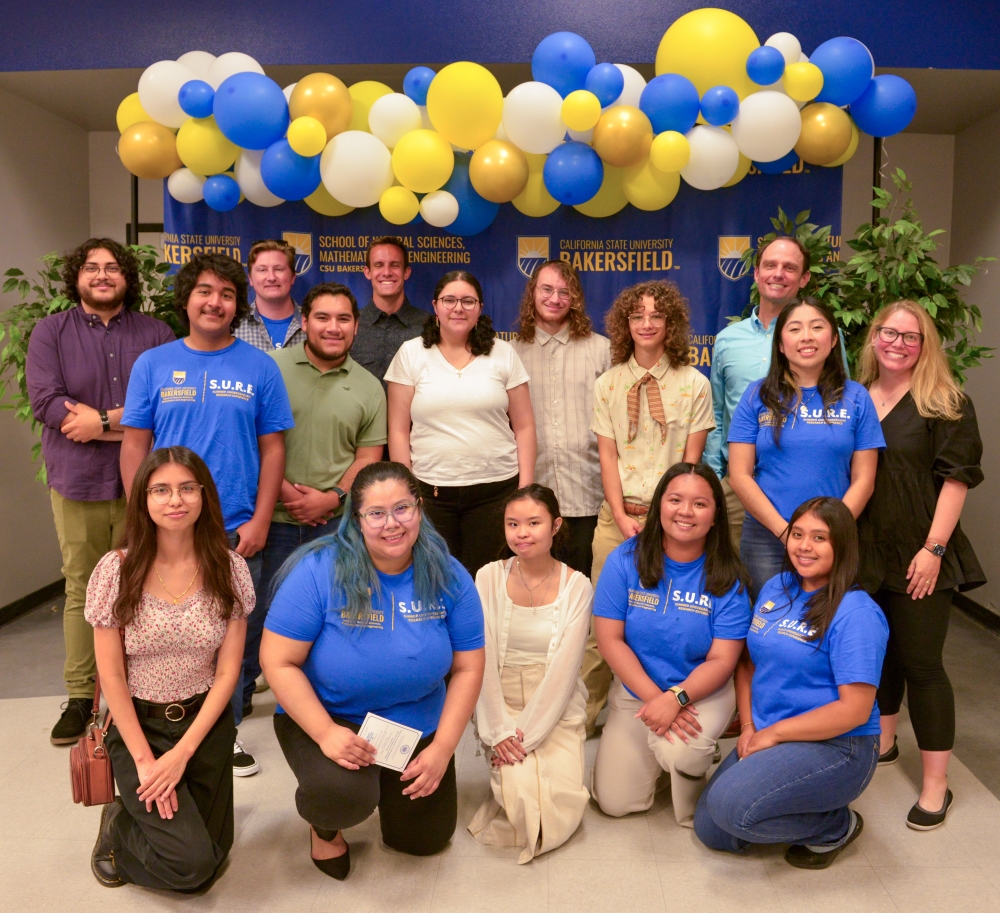
California State University Bakersfield
Welcome to the Webpage of
Dr. Anna L. Jacobsen
Plant Ecology and Evolutionary Biology
Plant Structure-Function
Lab Members and Research Projects
Dr. Jacobsen's Homepage Jacobsen Lab Research Methods Page Jacobsen Lab Publications

Jacobsen and Pratt SURE 2023 combined lab groups (not listed in order of appearance). Undergraduate participants: Adamari Torres, Elijah Swanson, Lhea Kathlyn Mae Domondon, Marcos Ramirez, Monica Uriaz, Ernesto Chavez, Cheri Tolentino, Jonathan Valencia, Maricruz Lopez, Ashley Osorio, Arthur Schneider. Graduate mentors: Samuel Del Rio, Antonio Mateiro, Jocelyne Lopez. Faculty mentors: Anna Jacobsen, Brandon Pratt.
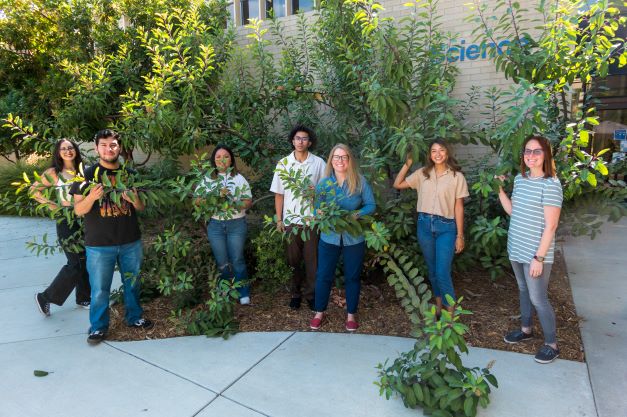
Jacobsen lab SURE 2022 working to examine leaf structure-function: Sara Ortiz, Fernando Tenorio, Lhea Domondon, Muhammad Ali, Dr. Jacobsen, Tagacy Valdez, and Danica Bergin.
"Leaf vessel length and leaf-stem connections: Structure of water transport pathways in woody plants" link
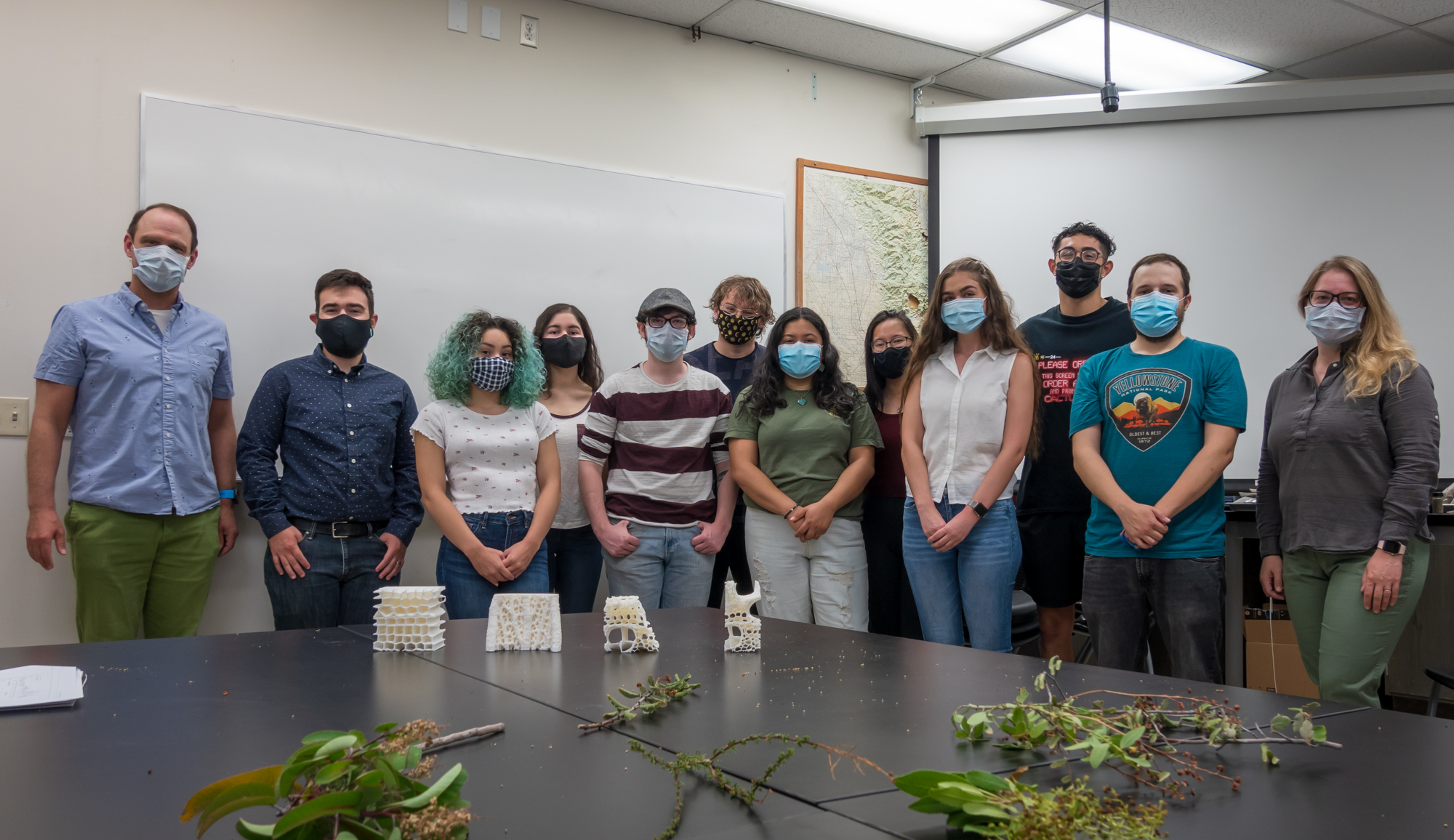
The combined Jacobsen and Pratt labs in August 2021 for the SURE program.
"Seed bank density and viability in Santa Catalina chaparral shrub species" link
"Oak trees and their response to drought and climate events" link
"Photosynthesis and stomatal conductance of shrub species from mediterranean-type climate regions" link

The Jacobsen lab in summer 2016 working to carefully excavate an intact long poplar root from a juvenile tree in our on-campus research plot:
Dr. Jacobsen, Marta, Jessica, Jackie, Jaycie, Catherine, Daniela, Emily, Alex (from foreground to background).

The combined Jacobsen and Pratt labs in January 2014:
Daniela, Marta, Justin, Courtney, Sam, Dr. Pratt, Dr. Jacobsen, Dr. Venturas (post-doc), Evan, Hayden, Jessica
Past lab members:
Undergraduates (alphabetical by last name):
Muhammad Ali
Wyatt Beller
Mark Bersentes
Shana Carey
Ernesto Chavez
Lhea Kathlyn Mae Domondon
Jessica Espinoza
Jaycie Fickle
Tamani Gause
Jesica Gonzalez
Mark De Guzman
Natalie Hernandez
Lawrence Ignacio
Maricruz Lopez
Marta Percolla
Jackeline Medina Arreguin
Sara Ortiz
Ashley Osorio
Raeanne Quaresma
Aaron Ramirez
Marcos Ramirez
F. Daniela Rodriguez-Zaccaro
Catherine Sanchez
Fernando Tenorio
Cheri Tolentino
Hayden Toschi
Gilberto Uribe
Tagacy Valdez
Jessica Valdovinos-Ayala
Alanisha Woods
Graduates (alphabetical by last name):
Robert Atwood (committee)
Genetic variation among populations of the Bakersfield cactus Opuntia basilaris var. treleasei, based on amplified fragment length polymorphisms.
Spring 2012
Alex Baer (advisor)
(CSUB Student Research Scholars Program 2016-2017)
Xylem functional traits at different tree positions within Populus trichocarpa.
Spring 2018
Aaron Baumgardner (committee)
(CSUB Crest Fellow 2018-2020)
Ecological effects of drought with a focus on its abiotic drivers: A case study examining southern California chaparral shrublands.
Summer 2018
Viridiana Castra (MS Biology) (committee)
(CSUB CREST fellow 2018-2020)
Balancing different functional demands in plant vascular tissue: Do conduit connections affect embolism propagation and transport efficiency?
Fall 2020
Mitchell Coleman (committee)
(CSUB Student Research Competition 2017 1st Place Graduate Presentation)
Factors affecting Atriplex polycarpa (Chenopodiaceae) seedling recruitment in invasive annual grasslands in the San Joaquin Valley of California: the role of residual dry matter and competition
Fall 2017
Dawn Fetzer (MS Geology) (committee)
Study of Summer Lake, OR BB3-1 Core via biogeochemical molecular and isotopic analysis for paleoclimate reconstruction
Spring 2016
Jaycie Fickle (MS Biology) (advisor)
(CSUB CREST fellow 2018-2020)
(CSUB School of Natural Sciences, Mathematics, & Engineering Outstanding Graduate of the School 2021)
Xylem structure and hydraulic function in the roots and stems of chaparral shrub species that occur at a high and low elevation site in the southern Sierra Nevada mountains, California
Summer 2020
Heather Keldgord (committee)
The distribution of sexes across a rainfall gradient in a subdioecious southern Californa chaparral shrub Rhus ovata S. Watson (Anacardiaceae).
Summer 2012
Evan MacKinnon (co-advisor)
(CSUB School of Natural Sciences, Mathematics, & Engineering Outstanding Graduate Thesis 2013)
A trait-based approach to restoring southern California habitats invaded by the Mediterranean grass Bromus madritensis ssp. rubens (Poaceae).
Spring 2013
Justin Martinez (advisor)
(CSUB Student Research Scholars Program 2013-2014, CSUB Graduate Student Research and Scholarship Initiative 2013-2014)
Hydraulics of different varieties of grapevine
Winter 2016
Marta Percolla (advisor)
(CSUB CREST fellow 2016-2018)
(CSUB School of Natural Sciences, Mathematics, & Engineering Outstanding Graduate Thesis and Outstanding Graduate of the School 2019)
Tracheids and vessels contribute to xylem hydraulic efficiency and safety of five California Quercus species (Fagaceae) along an elevation gradient.
Spring 2019
Courtney Traugh (committee)
Stem and root xylem trade-offs in carbohydrate storage, water stress tolerance, and biomechanics or sprouting and non-sprouting chaparral species.
Summer 2012
Post-doctoral Researchers and Visiting Research Scholars:
Dr. Gonzalo Perez de Lis (2019-2022)
Dr. Mustapha Ennajeh (2018-2019)
Dr. Martin Venturas (2014-2015)
Summer Undergraduate Research Experience (SURE Program):
Summer 2022
Muhammad Ali
Lhea Domondon
Sara Ortiz
Fernando Tenorio
Tagacy Valdez
Danica Bergin (graduate mentor)
Summer 2021
Wyatt Beller
Jessica Espinoza
Natalie Hernandez
Jordan Holmes (graduate mentor)
High school students (REVS-UP Program):
Summer 2015
Daisy Buenrostro
Viviana Firo
Brooke Herrera
Summer 2014
Ryan Romero
Jackie Lopez
Estevan Ramirez (teacher)
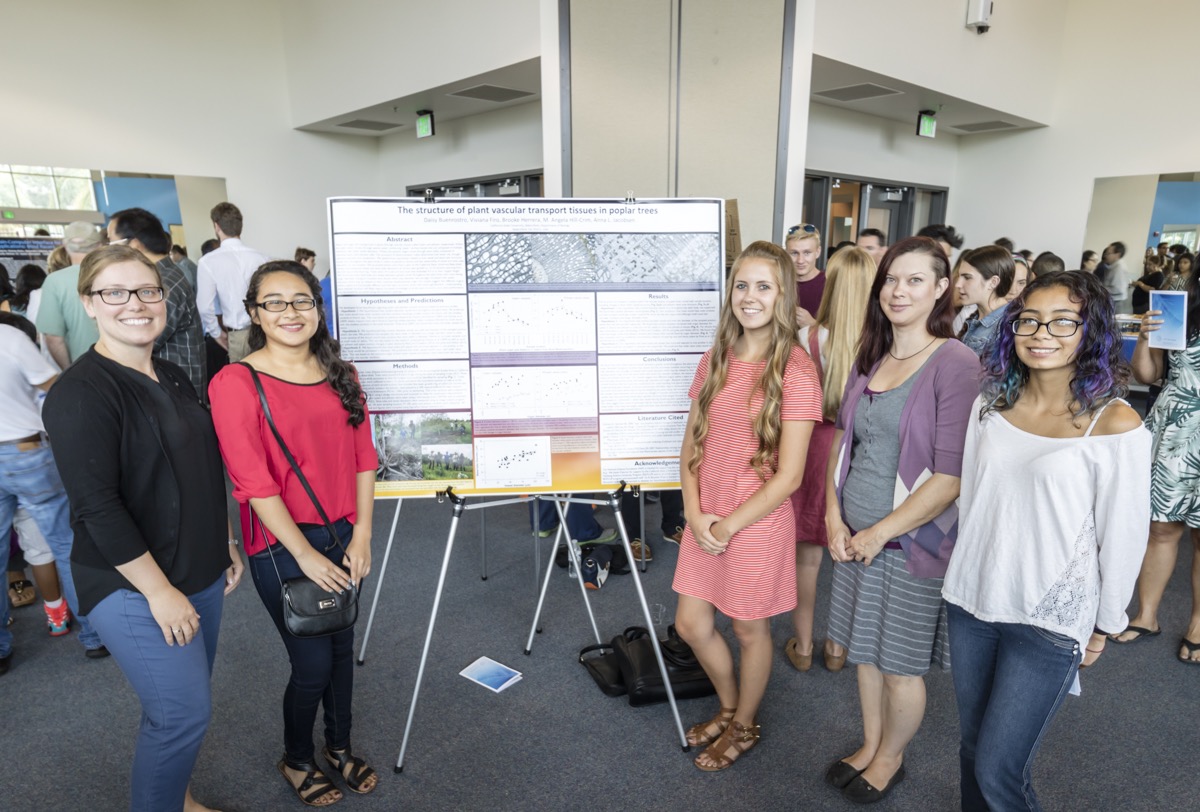
Jacobsen laboratory high school research participants in the REVS-UP Summer 2015.
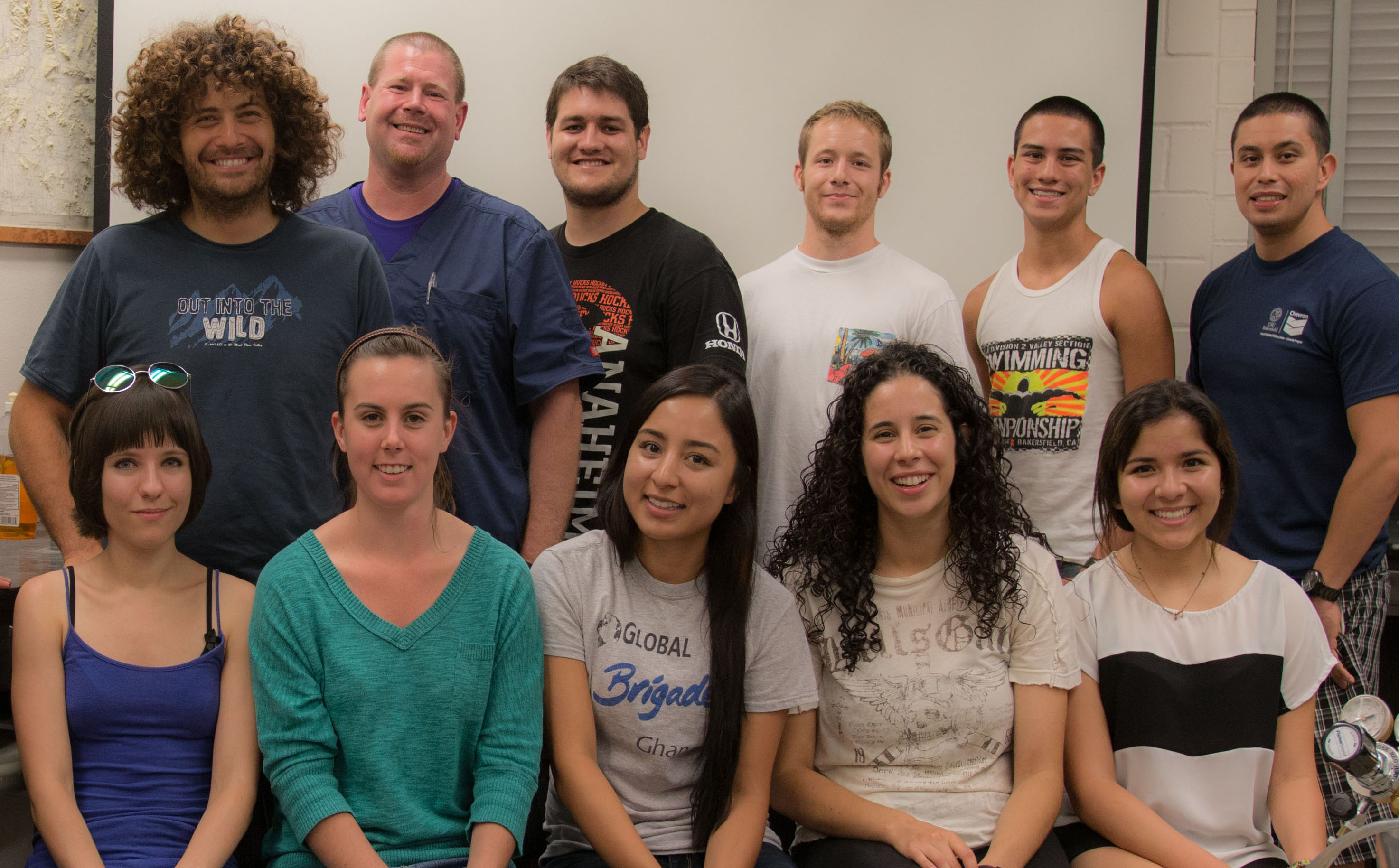
Jacobsen laboratory high school student and teacher research participants in REVS-UP (left) and with other members of the Jacobsen and Pratt labs (right) in Summer 2014.
Some of our lab research topics/projects include:
Drought resistance of woody plants from mediterranean-type climate regions: Supporting students through access to cutting-edge technology and a research-integrated international experience (supplement to NSF HRD-1547784)
Examining xylem vessel network structure and function in woody plants using developmental and intra-organismal systems (NSF IOS-1252232)
Natural resource solutions for water-limited paired mountain/valley systems (CSUB CREST, NSF HRD-1547784)
Plant hydraulic structure and function
Plant hydraulic responses to extreme drought
Fire ecology of Mediterranean-type climate region shrubs
Community convergence among arid and semi-arid shrublands in Mediterranean-type climate regions
Jacobsen laboratory research summary
Plants transport water through specialized water transport cells. In flowering plants, these cells, called vessel elements, combine to form long multi-cellular jointed tubes termed xylem vessels. In the Jacobsen lab, we are working to understand the structure of these vessels at the cellular-level and at the tissue-level. We are particularly interested in examining the structure of the three-dimensional vessel network of woody plants (i.e. how vessels develop and connect with one another throughout the tissues of a plant). Additionally, we are examining how vessel structure relates to the hydraulic function of plants. Vessels have three-dimensional structure, including significant curvature of vessels and significant changes in diameter of vessels (even along the length of a single vessel). Species can vary greatly in the interconnectedness of the vessel network and the density and structure of pitting between adjacent vessels. Work in our lab to examine inter- and intra-specific patterns in vessel length has yielded particularly interesting and exciting results, especially since this trait has sometimes been called the "neglected dimension" of vessel structure! Many students in the lab have conducted research or are continuing to conduct research examining vessel structural traits, including measuring vessel pit traits, vessel diameter, vessel length, and connectivity of the vessel network. As a lab, we are working to combine data from different levels of xylem organization (cellular to tissue) to develop a model of the vessel network. We are also working to quantify other elements of xylem structure, such as fiber and parenchyma cell structure and abundance.
Nearly all of the research projects in the lab are based on the broad idea of how plants use and move water, especially in response to stress. Thus, all of the research projects in the lab measure plant hydraulic function in some way. The most common measures of plant hydraulic function that are completed in the lab include measures of xylem resistance to water stress induced cavitation and measures of hydraulic conductivity (transport efficiency). Additional information about our methods for these measures may be found here. These methods have been important research tools that have allowed us to examine how plants respond to water stress. Extreme drought in California over recent years has enabled us to use these methods to investigate many different plant species, communities, and ecosystems to understand the impacts of drought.
There are five Mediterranean-type climate regions globally and they are each dominated by evergreen, tough-leaved shrub species; California represents one of these regions. The evergreen shrubs in these regions respond to fire by resprouting from modified root structures, recruiting through fire-cued seed germination, or through a combination of these strategies. We are currently investigating hypotheses related to how the xylem structure of resprouting plants relates to differential recovery of species post-fire, including why some species tend to suffer massive mortality during the first few years of post-fire recovery while other species are more resilient. Additionally, fire can have a profound effect on community composition of Mediterranean-type shrub communities. Several long-term collaborative research projects are investigating plant species and community response to fire, particularly in response to additional stresses such as heavy browse or drought. This work is being conducted at field sites in several locations throughout southern California, including the San Gabriel and Santa Monica Mountains, as well as on Santa Catalina Island off the coast of Los Angeles, California, and in the Western Cape Region of South Africa.